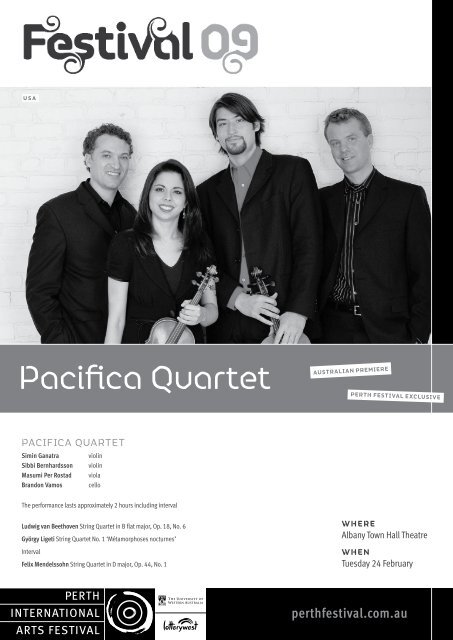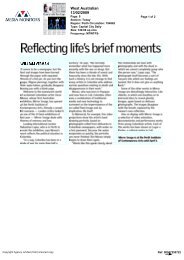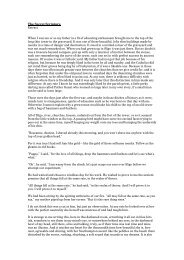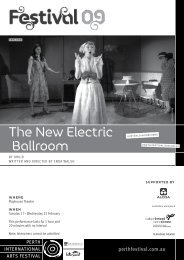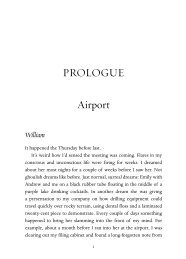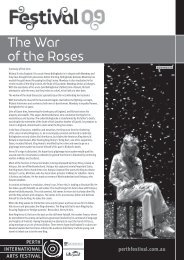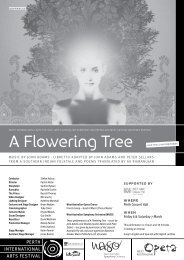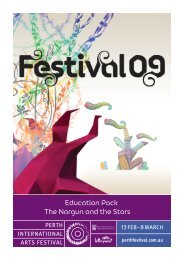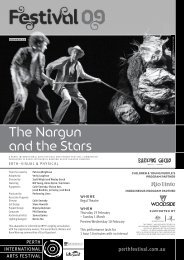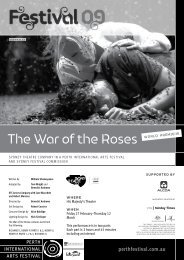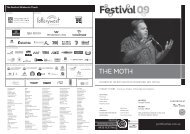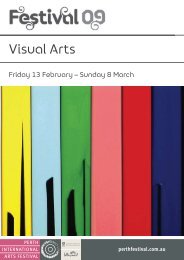Event Program - Perth International Arts Festival 2009
Event Program - Perth International Arts Festival 2009
Event Program - Perth International Arts Festival 2009
Create successful ePaper yourself
Turn your PDF publications into a flip-book with our unique Google optimized e-Paper software.
USA<br />
Pacifica Quartet<br />
australian Premiere<br />
perth festival exclusive<br />
PACIFICA QUARTET<br />
Simin Ganatra<br />
Sibbi Bernhardsson<br />
Masumi Per Rostad<br />
Brandon Vamos<br />
violin<br />
violin<br />
viola<br />
cello<br />
The performance lasts approximately 2 hours including interval<br />
Ludwig van Beethoven String Quartet in B flat major, Op. 18, No. 6<br />
György Ligeti String Quartet No. 1 ‘Métamorphoses nocturnes’<br />
Interval<br />
Felix Mendelssohn String Quartet in D major, Op. 44, No. 1<br />
WHERE<br />
Albany Town Hall Theatre<br />
WHEN<br />
Tuesday 24 February<br />
perthfestival.com.au
2<br />
Pacifica Quartet<br />
Simin Ganatra violin Sibbi Bernhardsson violin<br />
Masumi Per Rostad viola Brandon Vamos cello<br />
Recognised for its virtuosity, exuberant performance style and often daring<br />
repertory choices, the Pacifica Quartet has carved out a compelling musical<br />
path. Capping a remarkable <strong>2009</strong>, Musical America named the group its<br />
‘Ensemble of the Year’ and the Quartet received the music industry’s most<br />
coveted recognition, a Grammy Award nomination for ‘Best Chamber Music<br />
Performance’ for their recording of Elliott Carter’s String Quartets Nos. 1 & 5<br />
(Naxos). Since forming in 1994, the Pacifica Quartet has swept top awards in<br />
the US and abroad, including the prestigious Avery Fisher Career Grant – only<br />
the second chamber music ensemble ever selected.<br />
The Pacifica Quartet tours extensively throughout the United States, Europe,<br />
Asia and Australia, performing in the world’s major concert halls in cities<br />
such as Paris, London, Amsterdam, Vienna, Tokyo and <strong>Perth</strong>. Each season<br />
the ensemble can be heard on many prominent radio broadcasts, including<br />
Chicago’s WFMT, Boston’s WGBH, National Public Radio’s Performance Today<br />
and Minnesota Public Radio’s St. Paul Sunday.<br />
Prolific in the recording studio, the Pacifica Quartet’s CD Declarations: Music<br />
Between the Wars showcases music composed during the turbulent decades<br />
between WWI and WWII. In January 2008 the Quartet released the first in a<br />
two-disc set of the complete string quartets of Elliott Carter on the Naxos label<br />
in celebration of the composer’s 100th birthday. Their recent recordings of the<br />
complete string quartets of Felix Mendelssohn have also attracted effusive<br />
praise from critics in the US and abroad. On the heels of the release, the<br />
ensemble was featured on the cover of Gramophone magazine.<br />
Over the course of the 2008/09 season, in celebration of Felix Mendelssohn’s<br />
200th birthday, the Pacifica Quartet will present the cycle of his complete<br />
string quartets in New York City during a series of hour-long lunchtime concerts<br />
at Columbia University. These performances will include commentary by<br />
the members of the Quartet. This series is an encore of the successful and<br />
widely publicized Beethoven Cycle at Columbia in 2007/08. The Quartet<br />
will also perform the complete Mendelssohn cycle in Pittsburgh’s Carnegie<br />
Hall. Continuing its sell-out season performing Beethoven Cycles around the<br />
world, they will participate in cycles in Portland and Seattle as well as at the<br />
Metropolitan Museum of Art.<br />
Unique in the chamber music world, the Pacifica Quartet will also present<br />
cycles of Elliott Carter’s groundbreaking quartets in San Francisco, at London’s<br />
Wigmore Hall and at Lisbon’s Gulbenkian Foundation. These arduous<br />
concerts – true labours of love – will complement the release of the second<br />
Naxos disc of the Carter quartets. Previous Carter cycles elicited fabulous<br />
reviews. The New York Times wrote glowingly of the ‘astounding performances’<br />
and the Chicago Tribune praised the Quartet’s ‘astonishing talent, energy<br />
and dedication’.<br />
The Pacifica was appointed a member of The Chamber Music Society of<br />
Lincoln Center’s CMS Two program for gifted young musicians in 2002. The<br />
position involved the Quartet in a full range of activities organised by The<br />
Chamber Music Society of Lincoln Center, from performances in Alice Tully<br />
Hall to community partnerships and leading roles in the Society’s educational<br />
activities. In January 2008 the Quartet performed the Carter Cycle at Lincoln<br />
Center and in November 2008 participated in the Chamber Music Society’s<br />
festival honouring Klaus Lauer.<br />
The Pacifica Quartet is an ardent advocate of contemporary music,<br />
commissioning and performing as many as eight new works a year. As<br />
resident string quartet for Contempo, a leading contemporary music<br />
organisation, the Quartet presents a series of concerts each year devoted<br />
exclusively to new music.<br />
In 2004 the Pacifica Quartet was appointed Faculty Quartet-in-Residence at<br />
the University of Illinois in Urbana-Champaign. The Quartet members also<br />
serve as resident performing artists at the University of Chicago and at the<br />
Longy School of Music in Boston. Reflecting its dedication to musicians and<br />
music lovers of the next generation, the Pacifica Quartet was instrumental in<br />
creating the Music Integration Project, an innovative program that provides<br />
musical performances and teacher training to inner-city elementary schools.<br />
In addition the Quartet regularly teaches and performs at summer festivals,<br />
including Maverick Concerts, Caramoor <strong>International</strong> Music <strong>Festival</strong>, Fontana<br />
Chamber <strong>Arts</strong>, Music in the Vineyards, Interlochen <strong>Arts</strong> Camp and the<br />
Madeline Island Music <strong>Festival</strong> and is also frequently invited for visiting<br />
residencies at universities and schools.<br />
The members of the Pacifica Quartet share a unique history of personal and<br />
musical friendship. First violinist Simin Ganatra, born and raised in Southern<br />
California, initially played with cellist Brandon Vamos and violinist Sibbi<br />
Bernhardsson while they were all teenagers. Sibbi later introduced violist<br />
Masumi Per Rostad to the group. Originating on the West Coast, where it<br />
played many of its earliest concerts together, the Quartet takes its name from<br />
the awe-inspiring Pacific Ocean. Throughout their journey as a string quartet,<br />
its members continually strive to be ‘Distinct as the billows/yet one as the sea’<br />
(James Montgomery).<br />
For more information about the Pacifica Quartet, please visit:<br />
www.pacificaquartet.com<br />
Ludwig van Beethoven (1770–1827)<br />
String Quartet in B flat major, Op. 18, No. 6 (1897–1800)<br />
i. Allegro con brio<br />
ii. Adagio, ma non troppo<br />
iii. Scherzo: Allegro<br />
iv. La Malinconia: Adagio; Allegretto quasi allegro<br />
Although written fifth, Beethoven probably placed the B-flat quartet last<br />
because of the lengthy, slow introduction to the last movement, La Malinconia<br />
(melancholy), which gave the work its subtitle. From the viewpoint of musical<br />
development, this introduction is decades ahead of the rest of Op. 18. In some<br />
ways it presages the late quartets of the 1820s, with its moving evocation<br />
of grief and despair; it provides, as well, an insight into the depths of<br />
Beethoven’s emotional state.<br />
The first movement opens with a vigorous, upward-leaping theme in the<br />
first violin that eventually becomes a duet with the cello. The far less agile<br />
subsidiary theme stays rooted on one note and then another, all within<br />
a rather narrow range. The development section ends with a held note,<br />
anticipating the return of the melodies, little changed from their original<br />
appearance.
A refined, dignified melody is the main theme of the Adagio, which is<br />
organised into three-part, ternary form. The theme is introduced by the first<br />
violin over a bare-bones type of accompaniment. For the second violin repeat,<br />
the importance of the accompanying voices is considerably higher. The entire<br />
quartet joins for a brief episode together before the violin states the theme<br />
for the third time, now in a highly ornamental style. The contrasting section<br />
arrives with a thin, tenuous line played in octaves by the first violin and cello.<br />
A short bridge passage and rising chromatic scale in the first violin lead to the<br />
return of the opening theme, this time even more highly decorated than in its<br />
first hearing.<br />
The Adagio’s stately mood is unceremoniously shattered by the eccentric and<br />
very original Scherzo that follows. Full of rhythmic verve, it is constantly being<br />
tripped up and sabotaged by misplaced accents and cross rhythms. One can<br />
only marvel at Beethoven’s ability to squeeze such intricate and complex<br />
rhythmic patterns into straightforward triple meter. The slight trio, a flowing<br />
violin solo with a short transition, leads back to a literal repeat of the Scherzo.<br />
The Finale, the climax of the entire composition, begins with the astounding<br />
La Malinconia, which Beethoven directs ‘must be played with the greatest<br />
delicacy’. The introduction falls into two parts, the first characterised by<br />
repeated tones and the second by a fugal, imitative texture. Woven throughout<br />
is a three-note turn, or gruppetto, which is inserted as a decoration before a<br />
longer note. Several times, loud and soft chords alternate, each one preceded<br />
by a gruppetto, which adds even more gloom to the phrase. The main body of<br />
the movement is fast, in the style of a danze alla tedesca, or German dance,<br />
which was very popular at the time. Although the tedesca never succeeds<br />
in raising the sombre pall cast by La Malincoina, as if to underscore the<br />
point, Beethoven twice interrupts the gay dance with short reminders of the<br />
slow introduction, before letting the tedesca dash furiously to the powerful<br />
last chords.<br />
From Guide to Chamber Music © Melvin Berger. Used with Permission.<br />
György Ligeti (1923–2006)<br />
String Quartet No. 1 ‘Métamorphoses nocturnes’ (1953–54)<br />
i. Allegro grazioso<br />
ii. Vivace, capriccioso<br />
iii. Adagio, mesto<br />
iv. Presto<br />
v. Andante tranquillo<br />
vi. Tempo di Valse, moderato, con eleganza, un poco capriccioso<br />
vii. Allegretto, un poco gioviale<br />
viii. Prestissimo<br />
When György Ligeti composed his Quartet no. 1 during the years 1953–54,<br />
both the performance and publication of the work were out of the question in<br />
his native Hungary. Although he held a prestigious teaching position at the<br />
Ferenc Liszt Academy in Budapest, the political and ideological climate of the<br />
country was opposed to the artistic avant-garde. As one writer has commented:<br />
‘Musical innovation was as unthinkable as political dissent.’ Ligeti felt<br />
compelled by his artistic integrity to write such pieces, but he kept them<br />
hidden in his desk drawer until circumstances proved more favourable. The<br />
quartet’s premiere came two years after the composer had fled from Hungary<br />
during the anti-communist uprising of 1956, and took place in Vienna.<br />
The major musical challenge faced by Ligeti in writing the work was how to<br />
progress beyond Bartók’s great quartets. While several of these works were on<br />
the index of compositions banned from public performance in Hungary, Ligeti<br />
knew them in score and admired them. To address the challenge, Ligeti paid<br />
homage to the outstanding achievement of his predecessor, but did so in his<br />
own voice and manner. One of the clearest signs of his explicit transformation<br />
of the Bartók tradition is in the title of the work itself. The adjective ‘nocturnes’<br />
is reminiscent of the older composer’s celebrated ‘night music’ style, while<br />
the use of the noun ‘métamorphoses’, indicates Ligeti’s intention to transform<br />
the Bartók inheritance. In terms of the musical material, the quartet contains<br />
several deliberate reminiscences of passages in Bartók’s quartets, but Ligeti<br />
adopts a freer approach both to musical form and thematic structure than is<br />
typical of the Bartók works.<br />
Ligeti commented that the structure of the quartet could be interpreted as<br />
either a single-movement or as a number of shorter, linked sections. Each of<br />
these sections is contrasted to each other with regard to expression, tempo,<br />
texture, timbre and internal structure, though there are also connections<br />
between the various subsections as well as abrupt discontinuities. The work<br />
begins with a melodic cell made up of two major seconds a semitone apart<br />
(repeated literally three times during the course of the quartet). This cell<br />
is accompanied by a type of rhythmic neutrality in which no strong sense<br />
of metre is projected. As the work proceeds, the interval of a major second<br />
gradually expands to a major seventh and minor ninth and is often combined<br />
with changes in both tempo and texture.<br />
Ligeti makes use of more unusual tonal colourings, such as a quarter-tone<br />
trill-like figure in the cello part in one subsection and enharmonic unison<br />
octaves played simultaneously in another (two of the instruments playing an<br />
A sharp, for example, while the other two play its enharmonic equivalent, B<br />
flat). Other striking gestures are the mechanical reiteration of a single note,<br />
most noticeably in the strong pizzicatos in the cello part near the end of the<br />
quartet, as well as Ligeti’s own direction at the beginning of the Prestissimo<br />
to play ‘very evenly, like a precision mechanism’. There is also a brief fugal<br />
section and the use of other contrapuntal devices, such as the layering of<br />
four different textures. At the very conclusion of the quartet Ligeti writes the<br />
direction ‘senza misura’ (unmeasured), so that the work ends, in a finely<br />
balanced, symmetrical way, with the same sense of rhythmic freedom with<br />
which it began.<br />
Annotation © Robert Forgacs, courtesy Musica Viva Australia<br />
Felix Mendelssohn (1809–1847)<br />
String Quartet in D major, Op. 44, No. 1 (1838)<br />
i. Molto Allegro vivace<br />
ii. Menuetto: Un poco Allegretto<br />
iii. Andante espressivo ma con moto<br />
iv. Presto con brio<br />
The manuscript of the D Major quartet, the last of the three in Op. 44 to<br />
be completed, is dated Berlin, July 24, 1838. In a July 30 letter to violinist<br />
Ferdinand David, Mendelssohn suggests that it is one of his favourites, which<br />
may explain why it appeared first in the published version. ‘I have just finished<br />
my third Quartet, in D Major,’ he wrote, ‘and like it much. I hope it may please<br />
you as well. I rather think it will, since it is more spirited and seems to me<br />
likely to be more grateful to the players than the others.’<br />
The first movement is particularly ‘spirited’ and ‘grateful’ in its writing; it fairly<br />
crackles with energy and exuberance. After the first violin statement, all the<br />
players share in the extension of the lusty principal theme. The second subject<br />
is much more restrained and introverted, a sharp contrast to the free-flying<br />
opening. The development, with great verve and dash, works over the various<br />
motifs of the main theme. The recapitulation and coda carry the movement<br />
through to the end.<br />
To act as a calming, moderating influence after the high-powered first<br />
movement, Mendelssohn replaces the scherzo with a gentle Menuetto. The<br />
middle section features a ceaseless flow of eighth notes against either long<br />
sustained notes or little snatches of countermelody. The Menuetto, much<br />
shortened, returns to end the movement.<br />
There is a poignancy and intimacy in the third movement that one rarely<br />
encounters in Mendelssohn’s chamber music. Written in sonata form, both<br />
themes are constructed in the same way – a lovely, lyrical melody in the first<br />
violin and an equally important, and attractive, faster-moving countermelody<br />
in the second. The development is simply a brief transition from the second<br />
theme back to the first. In the recapitulation, the viola adds another<br />
countermelody to the return of theme one; the reprise of the second theme,<br />
though, is little changed.<br />
After the two quiet inner movements, Mendelssohn obviously felt the need<br />
for a brilliant finale, and the Presto con brio more than fills the bill. It is a fiery<br />
saltarello, his version of a high-spirited 16th-century Italian dance form. There<br />
are two parts to the principal theme, one potent and forceful, the other gentler<br />
and more tender. The second theme is a soft, lyrical descending line similar to<br />
the second motif of the first theme.<br />
Notes from Guide to Chamber Music by Melvin Berger. Used with permission.<br />
3
the festival Wishes to thank<br />
FOUNDER<br />
PARTNERS<br />
PRINCIPAL SPONSORS<br />
PREMIER SPONSORS<br />
MAJOR SPONSORS<br />
PUBLIC FUNDING PARTNERS<br />
INTERNATIONAL FUNDING PARTNERS<br />
Government of Western Australia<br />
Department of Local Government<br />
and Regional Development<br />
Government of Western Australia<br />
Department of Culture and the <strong>Arts</strong><br />
Government of Western Australia<br />
Department of Education and Training<br />
THE AGENC Y FOR CULTUR AL AFFAIRS<br />
GOVERNMENT OF JAPAN<br />
SPARKLING WINE SPONSOR<br />
MEDIA SUPPORTERS<br />
MEDIA PARTNER<br />
suPPORtiNG<br />
sPONsORs<br />
303 Group<br />
Friends of the <strong>Festival</strong><br />
Good Reading Magazine<br />
St John of God Health Care<br />
The Marketing Centre<br />
sPEcial<br />
tHaNKs tO<br />
Albany Advertiser<br />
Albany Chamber of Commerce and Industry<br />
Albany Public Library<br />
Bankwest<br />
Box Deli<br />
Brett & Annie Fogarty<br />
Carillion City<br />
Devilles Pad<br />
Fletcher Jones<br />
Fremantle Press<br />
Fonterra Brands Australia –<br />
Connoisseur Ice Cream<br />
Goethe Institut<br />
HarperCollins Australia<br />
HBF<br />
Howard + Heaver Architects<br />
Insight Publications<br />
Jordano<br />
Just Jeans<br />
Kansai Electric Power Australia<br />
Katies<br />
Maggie T<br />
Mink<br />
Murdoch Books<br />
Must Winebar<br />
Myer<br />
Osaka Gas Australia<br />
Pan Macmillan<br />
Playhouse Theatre<br />
Politix<br />
Random House NZ<br />
Resort Report<br />
RM Williams<br />
Scribe Publications<br />
State Library of Western Australia<br />
Target<br />
The Albany and Great Southern Weekender<br />
The Brisbane Hotel<br />
UNSW Press<br />
Vodafone / First Mobile<br />
Water Corporation, Albany<br />
Western Australian Museum, Albany<br />
writingWA<br />
ME Dic i<br />
DONORs<br />
Peter & Tracey Bacich<br />
Zelinda Bafile & Adrian Iredale<br />
Clive & Barbara Brans<br />
Peter & Robin Briggs<br />
Dr Charles Bro & Anne Marie Brittain<br />
Peter & Yvonne Burns<br />
Dr David Cooke<br />
John & Sarah D’Onofrio<br />
Marco D’Orsogna<br />
Murray & Louise Etherington<br />
Adrian & Michela Fini<br />
Brett & Annie Fogarty<br />
Graham Foreward & Jackie Gilmour<br />
Derek Gascoine & Dale Harper<br />
Peter & Chris Gilmour<br />
Mack & Evelyn Hall<br />
Peter & Sue Harley<br />
Maxine Howell-Price<br />
Adam Lenegan<br />
Sandy & Michele MacKellar<br />
John & Elizabeth Mair<br />
Michael & Sallie Manford<br />
Bettina Mangan<br />
Murray & Suzanne McGill<br />
Ian & Jayne Middlemas<br />
David & Dawn Morgan<br />
Professor Gerry O’Driscoll & Dr Halina Burmej<br />
John & Helen Owenell<br />
Mimi Packer<br />
Richard Payne & Cim Sears<br />
Dr Michael Prichard & Beniza Panizza<br />
Pearl Proud<br />
Marijana Ravlich<br />
Bill Repard & Jane Prendiville<br />
Dr Sam Rogers<br />
Sally Savini<br />
Rosemary Sayer & Terry Grose<br />
Leo & Virginia Seward<br />
Jackie & Gary Steinepreis<br />
Dr Phillip & Jill Swarbrick<br />
Peter & Jane Thompson<br />
Rodney & Penny Thompson<br />
Frank & Rachael Torre<br />
Joe & Debbie Throsby<br />
Tim & Chris Ungar<br />
Ian & Margaret Wallace<br />
Melvin Yeo<br />
Ashley & Anita Zimpel<br />
PRivatE GiviNG<br />
PROGRam<br />
Jonathan Akerman<br />
Emeritus Professor Cora Baldock<br />
Bernard & Jackie Barnwell<br />
In memory of Dr Stella Barratt-Pugh<br />
Sue Boyd<br />
Ellen Broerse<br />
Janette Brooks<br />
Coral Carter<br />
Dr Barry Cassidy<br />
Dr Michael & Rose Chaney<br />
Craig Colvin<br />
Dr David Cooke<br />
Joanne Cruickshank<br />
Marco D'Orsogna<br />
Isobel Glencross<br />
David Griffiths<br />
Patricia & Dr Des Gurry<br />
Dorothea Hansen-Knarhoi<br />
James & Freda Irenic<br />
Nina & Ashley Jones<br />
Jennie Kennedy<br />
Dr Vivienne Lawrence<br />
Peter & Lynne Leonhardt<br />
Peter Mallabone<br />
Sophie Mark<br />
Gaye McMath<br />
Leo Moran<br />
Mary Napier<br />
Alison O'Dwyer<br />
Wayne & Pam Osborn<br />
Andrea Shoebridge<br />
Prof Fiona Stanley<br />
Prof Karen Simmer<br />
Suzanne Strobel<br />
Tuite Family<br />
J. van der Merwe<br />
Enrico Versteeg<br />
Diana Warnock<br />
Justice Christine Wheeler<br />
Dr Heather Whiting & Richard Hatch<br />
Margaret Whitter<br />
Ann Whyntie<br />
Associate Professor Michael Wise<br />
Brigid Woss<br />
Anonymous (14)


